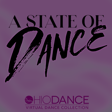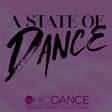
A Moving History with Dr. Candace Feck
OhioDance A State of Dance is a six-part series coming out the fourth Friday of each month through November 2023.
This podcast is driven by the OhioDance mission to secure the foothold of dance in Ohio through increasing visibility, firming viability, and elevating the position of dance in Ohio.
In 2016, a five-person team set out on a mission to capture the achievements of persons and institutions who have shaped the intricate diversity of dance history and practice within the state of Ohio and weave them together in an easily accessible digital format. This we call the OhioDance Virtual Dance Collection. As of 2023 we have highlighted 33 individuals and institutions. The team has traveled over 5000 miles and interviewed 100 individuals in all five regions of Ohio. In this inaugural episode we talk to Dr. Candace Feck, dance writer and oral historian for the Virtual Dance Collection about her life, her work with the VDC, and how inseparable dance is from our historical landscape. vdc.ohiodance.org
If you like what you are listening to and are not a member of OhioDance, you can go to ohiodance.org and click the membership button to join and receive the many benefits that come with your membership. You can also donate through our purple donate button.
OhioDance would like to thank our funders: Ohio Arts Council, National Endowment for the Arts, The Ohio State University Dance Preservation Fund, The Greater Columbus Arts Council, Columbus Foundation and Akron Community Fund.
Season One, Episode One: This month's guest is M. Candace Feck, Ph.D. Candace Feck is The OhioDance Virtual Dance Collection Oral Historian, Faculty Emerita in Dance, The Ohio State University, B.A. Cultural Anthropology; MA in Dance; PhD Art Education. Dr. Feck’s essays, criticism and research have been shared in numerous presentations, and published in journals, films, websites and archives. She completed an oral history of Bebe Miller, housed in the New York Public Library Dance Collection. She was a member of the NEA-funded Accelerated Motion: Toward a New Dance Literacy in America. She is the recipient of a Michael Sherker Award (1998) and a National Dance Association Award (2000).
Host: Rodney Veal
Executive Producer: Jane D’Angelo
Editor and Audio Technician: Jessica Cavender
Music Composition: Matthew Peyton Dixon




